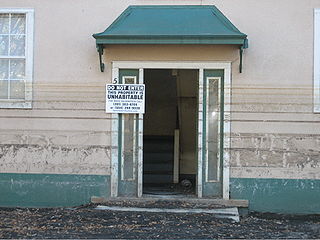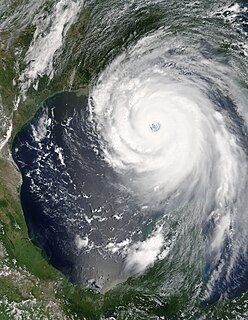
Hypertext is text displayed on a computer display or other electronic devices with references (hyperlinks) to other text that the reader can immediately access. Hypertext documents are interconnected by hyperlinks, which are typically activated by a mouse click, keypress set or by touching the screen. Apart from text, the term "hypertext" is also sometimes used to describe tables, images, and other presentational content formats with integrated hyperlinks. Hypertext is one of the key underlying concepts of the World Wide Web, where Web pages are often written in the Hypertext Markup Language (HTML). As implemented on the Web, hypertext enables the easy-to-use publication of information over the Internet.

As the center of Hurricane Katrina passed southeast of New Orleans on August 29, 2005, winds downtown were in the Category 1 range with frequent intense gusts and tidal surge. Hurricane-force winds were experienced throughout the city, although the most severe portion of Katrina missed the city, hitting nearby St. Bernard and Plaquemines parishes. Hurricane Katrina made its final landfall in eastern St. Tammany Parish. The western eye wall passed directly over St. Tammany Parish, Louisiana as a Category 3 hurricane at about 9:45 am Central Time, August 29, 2005. The communities of Slidell, Avery Estates, Lakeshore Estates, Oak Harbor, Eden Isles and Northshore Beach were inundated by the storm surge that extended over six miles inland. The storm surge affected all 57 miles (92 km) of St. Tammany Parish's coastline, including Lacombe, Mandeville and Madisonville. The storm surge in the area of the Rigolets Pass was estimated to be 16 feet, not including wave action, declining to 7 feet (2.1 m) at Madisonville. The surge had a second peak in eastern St. Tammany as the westerly winds from the southern eye wall pushed the surge to the east, backing up at the bottleneck of the Rigolets Pass.

Hurricane preparedness in New Orleans has been an issue since the city's early settlement because of its location.

Criticism of the government response to Hurricane Katrina consisted primarily of condemnations of mismanagement and lack of preparation in the relief effort in response to Hurricane Katrina and its aftermath. Specifically, there was a delayed response to the flooding of New Orleans, Louisiana.

The reconstruction of New Orleans refers to the rebuilding process endured by the city of New Orleans after Hurricane Katrina destroyed much of the city on August 29, 2005. The storm caused levees to fail, releasing tens of billions of gallons of water. The levee failure contributed to extensive flooding in New Orleans area and surrounding parishes. About 80% of all structures in Orleans Parish sustained water damage. Over 204,000 homes were damaged or destroyed, and more than 800,000 citizens displaced — the greatest displacement in the United States since the Dust Bowl of the 1930s. Wind damage was less severe than predicted. The damage that took place that needed to be repaired cost about $125 billion.

This article contains a historical timeline of the events of Hurricane Katrina on August 23-30, 2005 and its aftermath.
Commentators have discussed the likely effects of Hurricane Katrina on a wide range of political issues.

SBP is a nonprofit, disaster relief organization. After temporarily volunteering in St. Bernard Parish, Louisiana after Hurricane Katrina, Liz McCartney and Zack Rosenburg returned permanently in March 2006 and founded the project. The organization eventually expanded to include offices in Baton Rouge, Louisiana, Joplin, Missouri, Columbia, South Carolina, New Jersey, New York, and West Virginia. By August 2017, SBP had rebuilt over 1,200 homes nationwide, including 600 in New Orleans. They have collaborated extensively with Toyota and Americorps. As a result of its accomplishments, the organization and its founders have been recognized by Senator Mary Landrieu, CNN, and President Barack Obama.

Ultrasonic Studios was a music recording studio in New Orleans, Louisiana, USA. The studio was located on Washington Avenue in the Uptown neighborhood near Xavier University. It was established in 1977 by Jay Gallager and George Hallowell. The studio was sold to the two Grammy Engineers, David Farrell and Steve Reynolds, who ran the day-to-day operations. They co-owned the studio. In 2005, the studio suffered major damage from the levee failure disaster flood during Hurricane Katrina, and has not been back in operation since.

Gert Town is a neighborhood in the city of New Orleans, Louisiana. It is the home to Xavier University of Louisiana and is a part of the Mid-City District.

A.D.: New Orleans After the Deluge is a non-fiction graphic novel by cartoonist Josh Neufeld. Originally published as a webcomic, A.D. tells the stories of a handful of real-life New Orleans residents and their experiences during and after Hurricane Katrina. The graphic novel was a New York Times best-seller and was nominated for an Eisner Award and a Harvey Award in 2010. In addition, A.D. was selected for inclusion in The Best American Comics 2010.
Vectors is a peer-reviewed online academic journal published by the USC School of Cinematic Arts. It was established in March 2005 and covers the digital humanities, publishing work that "cannot exist in print". Vectors is recognized as an experimental precursor to the digital humanities, producing and publishing a range of highly interactive works of multimedia scholarship. Comparing Vectors with more traditional digital humanities publications, Patrick Svensson notes that, "Vectors, on the other hand, is clearly invested in the digital as an expressive medium in an experimental and creative way.". The journal no longer actively produces projects or provides support to journal contributors but does accept completed submissions on a rolling basis. The editors-in-chief are Tara McPherson of the USC School of Cinematic Arts and Steve F. Anderson of the UCLA School of Theater, Film & Television.

Congregation Beth Israel is a Modern Orthodox synagogue located in Louisiana. Founded in 1903 or 1904, though tracing its roots back to 1857, it is the oldest Orthodox congregation in the New Orleans region. Originally located on Carondelet Street in New Orleans' Central City, it constructed and moved to a building at 7000 Canal Boulevard in Lakeview, New Orleans, in 1971.
Blue Velvet may refer to:
Killer Entertainments is a joint venture by Jenny Terry and Raegan Kelly addressing the role of video in the War in Iraq. The project attempts to answer the question of how to present and analyze videos taken by soldiers and marines during combat without diminishing or sensationalizing their contribution. Terry and Kelly's resulting design cultivates the many attributes of the digital medium by making nonlinear connections lacking substantial narrative form. They present multiple viewpoints without focusing on a single argument, thus allowing the user to make their own interpretations.
United Saints Recovery Project is a 501(c)(3) non-profit located in the Central City neighbourhood of New Orleans which developed in the wake of Hurricane Katrina. It is a second-tier disaster response and community development organisation that exclusively harnesses the power of national and international volunteers to rebuild and preserve the city of New Orleans. The United Saints organisation was founded by Daryl Kiesow in 2007 after HandsOn organisation transitioned out of the neighbourhood. The United Saints main focus is to help communities affected by disasters and to revitalise economically distressed neighbourhoods. The United Saints Recovery Project operates out of First Street United Methodist Church on Dryades Street, New Orleans.
Post-racial United States is a theoretical environment in which the United States is free from racial preference, discrimination, and prejudice.
Hurricane Katrina has been featured in a number of works of fiction. This article is an ongoing effort to list the many books, movies, television shows, pop songs and comics that feature Hurricane Katrina as an event in the plot.











